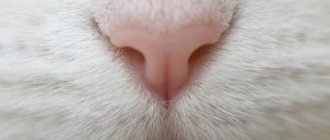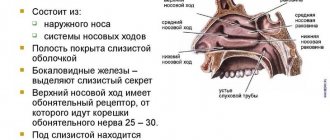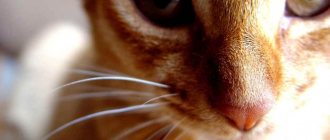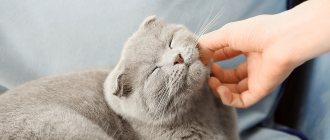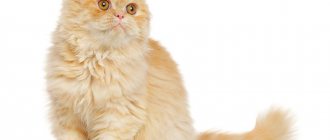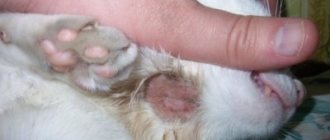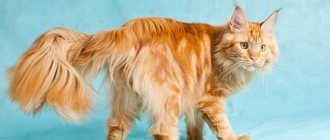Usually a cat's nose is cold due to the environment or simply because she likes to lick her nose. However, sometimes a wet nose can indicate an upper respiratory tract infection or even herpes. And in other cases, the answer may be as simple as “he drank from the bowl a few minutes ago.”
It is important to remember that a wet nose, as an indicator of a health problem, does not appear on its own. Make sure you keep a close eye on your cat, and if she shows other signs of illness, take her to the vet as soon as possible.
How does a cat's nose work?
If we could examine the animal’s nose from the inside, we would see two passages separated by cartilage tissue, through which oxygen enters the body. Inside, the nasal cavity is “wrapped” with a mucous membrane, which consists of nerve endings and blood vessels. The purpose of the mucous membrane is to protect the cat from bacteria and viruses that can be transmitted, for example, through contact with an infected individual. The mucous tissue, in turn, is lined with epithelium, consisting of olfactory receptors that allow the cat to capture the most subtle aromas that a person cannot feel.
During a person’s inhalation, oxygen enters directly into the lungs, while a cat, with the help of special shells and pores located inside the nasal passages, retains the captured air so that the epithelial receptors can send a signal to the brain: is there prey nearby, an individual of the opposite sex, or food. That is, during inhalation, a cat's nose does a much more complex job than a human nose. It is believed that a cat's sense of smell is at least 15 times more powerful than a human's. Therefore, a light and almost imperceptible aroma may seem too strong and unpleasant to a cat.
Nutrition
A cold nose in combination with other symptoms is an indicator that may indicate a weakened immune system . Owners who don’t bother about their cat’s diet prefer to limit themselves to buying dry food. Dry food causes dehydration of the body, followed by failure of internal organs. It is recommended to dose the daily amount of dry food with regular homemade food. Cats are predators, so the body requires natural food - meat.
Proper nutrition helps a cat build normal organ functioning, increase resistance to diseases, withstand negative environmental influences and always be in good shape.
Why does a cat usually have a wet nose?
Now let's look at why cats have wet noses. The moisture of the nose is caused by the secretion of nasal secretions or normal wetting with saliva. However, a dry nose is also not always a symbol of ill health. It is considered normal for an animal to have dry earlobes while sleeping or dozing, as well as within half an hour after waking up. A wet nose should not cause concern if the cat is actively playing, as a result of which its body temperature rises and the mucous membranes dry out. Your nose may also be dry if the room is too stuffy or it’s hot outside. In addition, the effect of a dry nose may be present if the cat is stressed, overeating or hungry. It has also been noted that dry earlobes occur more often than usual in representatives of some breeds (for example, Bengal cats). In other cases, a healthy pussy should have a moist and cool nose.
If your cat’s nose is dry and unpleasant symptoms are observed (lethargy, reluctance to eat, pale mucous membranes, changes in behavior, fever, gastrointestinal disorders, dull fur, pathological discharge from the eyes, etc.), you should consult a veterinarian as soon as possible. The nose can be dry, for example, due to dehydration, heart problems, and some infections.
Differential diagnosis of cough in children and its treatment
Cough is a protective mechanism for cleansing the bronchi and trachea. It occurs when exposed to “fast” or irritative receptors of mechanical and chemical stimuli and to “slow” C-receptors - mediators of inflammation. Rare cough shocks are physiological, they remove accumulation of mucus from the larynx; healthy children “clear their throat” 10–15 times a day, more in the morning, which should not alarm parents.
In the differential diagnosis of cough, it is very important to distinguish between its temporary characteristics: acute cough; persistent cough lasting three or more weeks after an acute episode; recurrent, occurring periodically; long persistent cough.
Types of cough
Acute cough . Characteristic of acute viral catarrh of the upper respiratory tract, as well as inflammation in the larynx (laryngitis, croup), trachea (tracheitis), bronchi (bronchitis) and lungs (pneumonia). When the respiratory tube is damaged, the cough is initially dry, unproductive - it does not lead to the discharge of sputum and is subjectively felt as intrusive. With laryngitis and tracheitis, it often acquires a barking character and a metallic overtone. A dry cough accompanies a sore throat with laryngitis. With pneumonia, the cough is usually wet from the first hours of illness and is often described as deep.
A wet cough is characteristic of a full-blown picture of bronchitis; its shocks end with the discharge of sputum (in small children this is perceived aurally), appearing again when it accumulates. The discharge of sputum is subjectively perceived as relief.
In the differential diagnosis of an acute cough, it is important to verify its connection with infection (fever, the presence of catarrhal syndrome). In a child with signs of acute respiratory viral infection (ARVI), hoarseness and difficulty in breathing indicate damage to the larynx with a possible threat of asphyxia (croup). Moist rales in both lungs indicate bronchitis: in older children they are usually large- and medium-bubble, in small children they are often small-bubble, which allows a diagnosis of bronchiolitis.
The key task in the presence of signs of acute respiratory infections is to exclude pneumonia - most often, wheezing is absent in the lungs or is heard over a limited area of the lung, where a shortening of the percussion sound and/or a change in the breathing pattern is also detected. The nature and strength of the cough does not indicate the etiology of pneumonia. An exception is the stokato cough in children with chlamydial pneumonia in the first months of life: “dry”, abrupt, ringing, followed by attacks, but without reprisals, accompanied by tachypnea, but not a febrile reaction.
Spasmodic cough is characteristic of bronchial asthma, and in children of the first years of life - with acute obstructive bronchitis or bronchiolitis. In these forms, wheezing is accompanied by prolongation of exhalation, which indicates the presence of bronchial obstruction. A spasmodic cough is usually unproductive, intrusive, and often has a whistling overtone at the end.
In the event of a sudden onset of cough, including spastic cough, without signs of acute respiratory viral infection, you should think about a foreign body in the respiratory tract, especially in a child who has not previously had a spastic cough. It is characterized by an attack of whooping cough - obsessive, but not accompanied by reprises. This cough may last for a short time; when a foreign body moves into the smaller bronchi, the cough may stop. A foreign body is often accompanied by swelling of one lung, over which weakening of breathing and, often, whistling exhalation are heard; with such symptoms, bronchoscopy is indicated.
Prolonged cough (more than 2 weeks). It is observed quite often, usually after acute bronchitis. Most often, it is associated not so much with the inflammatory process as such, but with post-infectious hyperproduction of sputum and, often, with hypersensitivity of cough receptors. When deciphering such a cough, it is important to take into account the child’s age.
In infants after obstructive bronchitis, the persistence of hypersecretion of mucus with an increase in the cough threshold causes a rare wet cough for 4 weeks or more; its distinctive feature is the presence of “hoarseness” - bubbling sounds in the chest, audible at a distance, which disappear after coughing and reappear as sputum accumulates. Sputum from the trachea and larynx in infants is evacuated by more rare cough shocks, when the lumen of the bronchi is almost completely blocked. In such children, coughing with pressure on the trachea (or with a spatula on the root of the tongue) is difficult to induce. The cough associated with hypersecretion gradually subsides, both in frequency and intensity.
However, cough associated with habitual aspiration of food due to dysphagia, the most common cause of prolonged cough in infants, both breastfed and artificially, should be excluded. Establishing the fact of dysphagia usually requires monitoring the feeding process, since not every mother pays attention to the connection between cough and food intake. In addition to “choking” and “coughing” during food, food aspiration is characterized by the appearance of wheezing, which quickly disappears or changes its location and intensity after a cough impulse. Chest radiography in such children usually reveals darkening or intensification of the pulmonary pattern in the upper lobes.
Cough when eating is also observed in the presence of a bronchoesophageal fistula; its distinctive feature is the separation of copious frothy sputum; the presence of this symptom requires a contrast study of the esophagus and esophagoscopy.
Children who, in addition to dysphagia, have gastroesophageal reflux are characterized by coughing attacks during sleep. Finding a wet pillow confirms this diagnosis.
A lingering cough in children of early and preschool age is often caused by the flow of mucus into the larynx from the nasopharynx with long-term nasopharyngitis, adenoiditis, and adenoid hypertrophy; Unlike cough with bronchitis, it is not accompanied by wheezing in the lungs, often has a superficial character and disappears when the process in the nasopharynx is treated. A prolonged episode of bronchitis with cough lasting 2–4 weeks is common in preschoolers with recurrent bronchitis.
A prolonged dry cough in school-age children and adolescents, which can last up to 6 weeks, is not uncommon with tracheitis or tracheobronchitis, which develops with certain respiratory viral infections (RS, rhino-, parainfluenza viruses). It is often painful, paroxysmal, and the attack ends with the discharge of a lump of dense mucus (fibrinous deposits). Special studies, however, have shown that among children of this age who have been coughing for more than 2 weeks, 25% or more experience whooping cough in their characteristic atypical form - without pronounced paroxysms and relapses.
This course of whooping cough is typical for both incompletely vaccinated children and children who received 3 vaccinations and revaccination at 18 months. The fact is that pertussis immunity gradually fades away and after 5–6 years—by school age—most vaccinated people become susceptible to this infection. Its atypical course in them contributes to late diagnosis (if it was carried out at all) and the spread of infection and infection of infants who have not yet received all vaccinations.
A lingering cough in adolescents with whooping cough is characterized by the absence of wheezing in the lungs; it usually does not intensify and does not acquire a specific character, as in those who have not been vaccinated. Sometimes, however, it is possible, by pressing with fingers on the trachea or with a spatula on the root of the tongue, to cause a semblance of a whooping cough shock with protrusion of the tongue, redness of the face, less often with a typical reprise. A bacteriological diagnosis of whooping cough in these children is rarely possible; it is more reliable to determine in the blood of antitoxic antibodies, which in sick people, unlike vaccinated ones, are present in high titers.
Recurrent cough . It is typical, first of all, for patients with bronchial asthma - this is one of the frequent complaints of parents of children whose asthma diagnosis has not yet been established. The cough that accompanies almost every episode of acute respiratory viral infection is also characteristic of recurrent bronchitis - it is usually wet, lingering, its duration exceeds 2 weeks, it is not accompanied by obvious signs of bronchospasm, which, however, is often detected during the study of pulmonary function (PRF) (test with bronchodilators).
With recurrent obstructive bronchitis (ROB) in children under 3–4 years of age, a cough—wet or “spastic”—occurs against the background of ARVI, usually in the presence of fever and catarrhal syndrome. Unlike cough in bronchial asthma, it does not have the character of an attack. However, by the type of cough, these two forms can hardly be distinguished, since cough and obstruction due to ARVI are the most common type of exacerbation of bronchial asthma, especially in young children. For many of them, the diagnosis of ROB eventually “flows” into the diagnosis of asthma, if such episodes are repeated more than 3-4 times or if periods of coughing are associated not with ARVI, but with an allergen, physical activity, cold air, or if they occur for no apparent reason at all - as a consequence of increased inflammatory changes in the bronchial mucosa.
Long, persistent cough . It is observed in chronic diseases of the respiratory system, which immediately distinguishes it from the types of cough described above. Of course, it can intensify or weaken at certain periods of time, but it is fundamentally important that the child coughs almost constantly.
A wet, persistent cough is observed in most suppurative lung diseases, accompanied by accumulation of sputum. The cough is often especially severe in the morning, and becomes less frequent after sputum has been removed. A cough that is “deeper” to the ear is typical of bronchiectasis; with defects of the bronchial cartilage (Williams–Campbell syndrome), it may have spastic overtones.
In cystic fibrosis, the cough is often intrusive and painful due to the viscosity of the sputum, often accompanied by signs of obstruction. The diagnosis is not difficult in the presence of other manifestations of cystic fibrosis - weight loss, polyfecal matter, tympanic fingers, etc., however, there are milder forms of this disease, so a study of sweat electrolytes is indicated in all children with a persistent cough.
A persistent dry cough with a change in voice may indicate laryngeal papillomatosis. A dry cough accompanied by shortness of breath, chest deformation, signs of cor pulmonale, and tympanic fingers is characteristic of fibrosing alveolitis.
Psychogenic cough deserves special attention , for which a persistent cough is also typical. This is usually a dry cough with a metallic tint, which is observed only in the daytime and disappears during sleep; its distinctive feature is regularity and high frequency (up to 4-8 times per minute), stopping during eating and talking. A psychogenic cough usually occurs as a reaction to stressful situations in the family and school, then becomes habitual; it often begins during an acute respiratory infection, quite quickly acquiring the character described above. In some children, this cough has the character of a tic or a manifestation of obsessive-compulsive disorder (Gilles de la Tourette syndrome).
Young children often cough when stressed, usually to achieve their goals; The cough intensifies before and during the doctor’s examination, stopping at the end of it (relieving “anticipation stress”). A new coughing attack can be provoked by touching on a topic that is unpleasant for the child (whims, keeping a daily routine) or even by simply starting an abstract conversation, without paying attention to the child. The reason for the strengthening of the cough reflex in a child may be increased anxiety of parents and concentration of their attention on respiratory symptoms. Such children require an in-depth examination to exclude organic pathology, sometimes trial treatment with antispasmodics and steroid aerosols.
Some types of cough differ in nature.
Bitonal cough (low, then high tones). Occurs with tuberculous granulations from a lymphobronchial fistula, sometimes with foreign bodies in large bronchi. Is an indication for bronchoscopy.
Cough when taking a deep breath . Accompanied by pain, indicates pleural irritation; it goes away after pain relief (codeine, Promedol). The same cough during restrictive processes is associated with increased lung rigidity (allergic alveolitis). Taking a deep breath also causes a cough in children with asthma - it occurs as a result of bronchial hyperreactivity; shallow breathing is an integral part of a number of physical therapy (physical therapy) systems used to treat asthma.
Night cough . Characteristic of bronchial asthma, it usually occurs closer to the morning due to increased bronchospasm; It often indicates an allergy to the feathers in the pillow. In some children, nocturnal cough is the equivalent of asthma, so these children should be assessed accordingly. Night cough is also observed with gastroesophageal reflux, while older children complain of heartburn. Quite often, night cough occurs in children with sinusitis or adenoiditis due to mucus entering the larynx and drying of the mucous membrane when breathing through the mouth.
Cough during exercise is a sign of bronchial hyperreactivity and is observed in a significant proportion of patients with bronchial asthma.
Cough with syncope - short-term loss of consciousness - occurs due to a decrease in venous inflow with an increase in intrathoracic pressure and, as a result, a decrease in cardiac output; The condition is benign and does not require treatment other than antitussives.
Cough treatment
The fight against cough has been fought by humanity since time immemorial - even now, when we know so much about cough, both parents and many pediatricians consider cough as an undesirable symptom and strive to stop it. Complaints about cough and persistent requests from parents to treat the cough are apparently connected not only with the fact that cough is a clear sign of a child’s ill health. Subjectively, the cough of a person nearby or in a close environment is perceived as an irritating, unnerving phenomenon. Hence the desire to stop coughing at all costs.
What new does the modern understanding of the nature of cough give us? Firstly, that there are several causes of cough and that it only makes sense to suppress coughs caused by “dry” inflammation of the mucous membrane of the respiratory tract - for example, with laryngitis, as well as coughs associated with irritation of the pleura. In those cases when the cough leads to the removal of sputum, suppressing it is impractical and even dangerous. It is important to explain to parents that coughing is a protective reaction aimed at clearing the airways in conditions of hypersecretion of mucus and reduced efficiency of mucociliary clearance. In practice, treatment of cough as such is required only in rare cases when it significantly disrupts the patient’s life.
Antibiotics . First of all, it is important to understand that the presence of a cough in itself is not a reason for antibiotic therapy. It is carried out only in cases of proven bacterial infection of the upper respiratory tract (otitis media, sinusitis, streptococcal tonsillitis) and lung damage (pneumonia, including chronic pneumonia, cystic fibrosis, lung malformations). With regard to acute bronchitis, it has been proven that antibacterial therapy is justified only for mycoplasma and chlamydial etiology (10–15% of the total number of bronchitis, more often at school age), while the majority of bronchitis, including obstructive ones, are viral diseases.
Antibacterial treatment of whooping cough, including those that occur in the form of a prolonged cough with an early onset (in the first 7–10 days), can interrupt clinical manifestations. At a later date, it is difficult to expect a great effect from antibiotics, but such treatment stops the release of bacilli within 2-3 days, so it is completely justified from an epidemiological point of view. Erythromycin (50 mg/kg/day) and clarithromycin (15 mg/kg/day) for 10–14 days or azithromycin (10 mg/kg/day) for 5 days have proven effectiveness.
Data on the use of the local antibiotic fusafungin (Bioparox) after tonsillectomy and adenotomy operations, as well as for adenoiditis and ARVI, have been published in the literature, primarily by otolaryngologists. The drug also has a local anti-inflammatory effect. Taking into account the fact that during ARVI, pneumococci and Haemophilus influenzae multiply, its use may be justified in children at risk. However, for proven bacterial infections (streptococcal tonsillitis, otitis media, etc.), Bioparox does not replace systemic antibiotics.
Treatment of laryngitis . When a barking cough accompanies laryngitis, it is customary to inhale hot steam - for example, in a bathroom with an open hot water tap. However, this type of treatment has been proven to be ineffective for both croup and bronchitis. A meta-analysis of numerous studies on the treatment of croup has shown that intramuscular dexamethasone (0.6 mg/kg) or, in milder cases, inhaled budesonide (Pulmicort) is most effective in preventing the development (or progression) of laryngeal stenosis. These remedies also help to quickly stop coughing.
Antitussives and expectorants . A dry cough is theoretically an indication for the prescription of antitussive drugs, but in most cases of ARVI, after a few hours it gives way to a wet cough, in which these drugs are contraindicated. As antitussives in children, mainly non-narcotic drugs are used - butamirate, dextromethorphan, glaucine, oxeladine, pentoxyverine (
). A recent study showed, however, that a spoonful of buckwheat honey at night calmed nocturnal coughs in children 2–18 years old with acute respiratory viral infections at least as well as a dose of dextromethorphan. And milk with alkali, tea with jam, etc. “homemade” remedies soothe a barking cough with pharyngitis (sore throat) no worse than “antiseptic” lozenges or sprays. This gave WHO grounds to recommend only home remedies for coughs.
In cases where it is necessary to prescribe medications for pharyngitis, taking into account the fact that most drugs contain antiseptics that disrupt the biocenosis of the oral cavity, it is preferable to use inhalations of Bioparox, a bacteriostatic agent that also has anti-inflammatory effects.
With a wet cough, cough suppression is unacceptable, so intervention is justified only if there is difficulty in sputum evacuation. The effectiveness of expectorants (mainly of herbal origin) is highly questioned; in addition, their use in young children may be accompanied by an allergic reaction and vomiting. However, these remedies (preparations of mint, marshmallow, licorice, oregano, coltsfoot, anise, wild rosemary, thyme, etc.) are widely used, which can be justified by their cheapness and safety (Table 2). But the use of expensive forms of such products, even if they contain extracts of exotic plants (Greenland herbs, quebracho, ivy leaves), cannot be justified. Rubbing the chest with preparations containing essential oils (eucalyptus, pine needles, etc.) and balms that are absorbed by the skin are no more effective than expectorants.
There are combination products on sale that contain both expectorants and antitussives (Bronholitin, Tussin, etc.) (). The idea of their creation is to make coughing less frequent, but more productive, which should reassure parents. These combinations also do not have proven effectiveness in children, but their testing in adult patients showed that such combinations do not improve sputum discharge, but significantly reduce respiratory function. It is unlikely that after this we can seriously recommend these remedies for practice.
Mucolytics . The use of mucolytics is more justified, especially in chronic diseases accompanied by an abundance of viscous sputum (cystic fibrosis, chronic pneumonia, bronchial malformations). The most pronounced mucolytic effect is that of N-acetylcysteine, which in pediatric practice is used mainly for cystic fibrosis and chronic pulmonary suppuration. However, it is difficult to classify it as an essential drug: for example, in the USA, acetylcysteine is used relatively rarely in patients with cystic fibrosis, with preference given to vibration massage. In the presence of purulent sputum in patients with cystic fibrosis, Pulmozyme (dornase-alpha) is indicated, which breaks down the DNA that accumulates in the sputum during the breakdown of cellular elements (
). The use of these agents is permissible only in conditions where postural drainage can be carried out after their administration.
Acetylcysteine should not be used in acute diseases, including bronchitis, since viscous sputum is rare in them, and there are no possibilities for postural drainage in case of “swamping” of the lung with liquid sputum, and this drug is approved from 12 years of age.
In acute and recurrent bronchitis, improvement of mucociliary transport is better achieved with the help of carbocysteine and ambroxol, the latter can be used both orally and as an aerosol in children receiving inhaled sympathomimetic for obstructive bronchitis.
Suppressing the cough that accompanies obstructive syndrome is also not an end in itself - the use of sympathomimetics, eliminating bronchospasm, also contributes to the cessation of cough (
). In case of status asthmaticus, accompanied by the formation of bronchial casts, attempts to use N-acetylcysteine can lead to increased bronchospasm.
Anti-inflammatory drugs . The use of locally acting inhaled corticosteroids (ICS) forms the basis of the treatment of moderate and severe bronchial asthma. Both metered dose inhalers (beclomethasone, budesonide, fluticasone) and nebulizer solutions with budesonide (Pulmicort) are used, especially in children under 3–5 years of age (Table 5). By suppressing inflammation in the bronchial mucosa, ICS help stop the cough it causes.
ICS can also be used for more severe respiratory infections, in which cough is associated primarily with an inflammatory process in the bronchial mucosa. In particular, the use of these drugs during the convulsive period of whooping cough reduces the frequency of coughing attacks and its intensity. ICS (together with sympathomimetics) can be used in the treatment of obstructive bronchitis (especially relapse of bronchitis) in young children. And although ICS does not shorten the duration of the disease, they have a positive effect on the severity of the acute period; There is also evidence of a reduction in the frequency of relapses of obstruction with continued treatment with ICS for 2–4 weeks after the end of the acute period. With prolonged cough due to tracheitis, ICS also often bring lasting relief.
The use of ICS, for obvious reasons, cannot be a “cough control” for most respiratory infections. An alternative to them is the non-steroidal anti-inflammatory drug fenspiride (Erespal - syrup 2 mg/ml), which, as a rule, does not have serious side effects. This drug improves mucociliary clearance, has activity as an antispasmodic and a blocker of H1-histamine receptors. In many patients, especially with recurrent bronchitis, including obstructive, chronic pathology, Erespal (at a dose of 4 mg/kg/day, in children over 1 year - 2-4 tablespoons per day) brings clear relief of cough and condition generally.
Treatment of psychogenic cough . Children with psychogenic cough are usually not helped by antitussives, expectorants, muco- and antispasmodics. Their treatment (after excluding a possible organic cause of cough) usually requires the prescription of antipsychotics, hypnotherapy and is carried out in conjunction with neuropsychiatrists. In the presence of compulsive-obsessive type disorders, there is experience in using slowly increasing doses of Clonidine. Treatment usually requires considerable time (many months), although in some cases the cough may suddenly disappear and begin again (in some cases in the form of obsessive sneezing).
V. K. Tatochenko , Doctor of Medical Sciences, Professor of the Scientific Center for Children's Medicine of the Russian Academy of Medical Sciences , Moscow
When a cat's wet nose is not good
As we found out, a cat's cold, wet nose is a sign of good health. But there are also exceptions to the rule, when moisture in the nose is present in sick animals. Let's look at some ailments that cause cats to have a wet nose:
- It is normal for a cat to have hot ears and a cold nose. However, if there is copious discharge from the nose and the ears are burning, an infection may be present (for example, panleukopenia, rhinotracheitis, etc.);
- A cat's very wet nose, combined with sneezing, refusal to eat, and elevated body temperature, may indicate that the animal has a cold;
- Sometimes the lobe becomes especially moisturized if a foreign object gets into the animal’s nasal passages. Moreover, the discharge can be not only transparent, but also bloody and purulent;
- A cat's nose often runs due to allergies. A pet may not tolerate, for example, the smell of cigarette smoke or the aromas of cleaning products. Allergic rhinitis can develop due to rejection of plant pollen, the administration of certain medications, dust;
- If your pet is snoring heavily, his nose is too wet, and he is breathing through his mouth, the problem may be the presence of a polyp on the nasal mucosa;
- The cause of a too wet nose and constant discharge from it may be the presence of a benign or malignant tumor;
- A wet and too pale nose may be a sign of cardiovascular disease;
- If the animal's nose is not only constantly too wet, but also cold, hypothermia (hypothermia) or poisoning can be suspected.
Excessive humidity
Allocations must be standardized. Any decrease or increase in them should alert the owners . Snorting and difficult breathing against a background of humidity may indicate the presence of polyps or damage to the inner surface of the nasal passages.
An excessively cold and wet organ is a sign of hypothermia or poisoning. A cold is suspected when there is a rise in temperature, sneezing, or excessive discharge.
High humidity is normal for Persians and other breeds with flattened faces.
How to care for a cat's nose
For the most part, cats are lovers of exemplary cleanliness, so they can take care of the beauty of their fur coat, eyes and nose on their own. However, if the purr neglects hygiene, it is permissible to clean the dirty nose with cotton swabs (possibly with a limiter) dipped in warm water.
If the animal’s nose is running like a faucet, cleaning will not be enough. In this case, it is necessary to observe the animal. Is your cat clearly not feeling well? High temperature, apathy, dull eyes, refusal of a favorite treat are reasons to contact a veterinarian as soon as possible.
Prevention
Black dots on a furry pet’s nose appear for a variety of reasons (physiological, pathological), among which are:
- breed, genetic predisposition;
- exposure to sunlight;
- metabolic failures;
- hormonal imbalance;
- errors in feeding, improper care;
- endocrine pathologies, chronic diseases;
- sudden change in diet;
- stress, emotional turmoil;
- violation of hygiene rules, feeding from dirty bowls;
- tendency to allergies;
- a sharp change in diet, switching to new foods;
- dermatological problems (contact, chronic, atypical, infectious dermatitis caused by viruses, fungi);
- mycoses;
- problems in the functioning of the liver and pancreas.
We suggest you familiarize yourself with the cat breathing with its mouth open after giving birth: causes and consequences
As a rule, the mechanism for the appearance of black dots on the nose of cats is associated with an excess, enhanced production of the melanin pigment (responsible for the dark color). Spots on the lobe most often appear with age and are very rare in young kittens.
As for breed predisposition, black spots on the nose can be found in Sphynxes, Devonrexes, Abbishinos, Siamese, Persian, and Himalayan cats.
Acne in cats
- Genetic predisposition can lead to increased activity of the sebaceous glands, which increases the risk of acne. In this case, you need to regularly use products that dry and cleanse the skin.
- Plastic food and water bowls, due to their porous structure, become a breeding ground for bacteria that cause infection and inflammation of the skin of the chin. There have been cases when replacing them with stainless steel containers completely solved the problem of rashes on the face. There is an assumption that the appearance of acne may also be an allergic reaction to plastic. Acne can also appear as a result of food allergies.
- Stress causes the release of adrenaline and cortisol, which stimulate the sebaceous glands, creating fertile ground for the formation of acne and pimples.
- Unbalanced diet. The appearance of black dots should be a signal to revise the diet towards reducing fat and enriching the diet with vitamins.
- It is difficult for a cat to keep its chin clean on its own. Washing with warm water after eating will remove the problem of contamination. Your pet's dishes should be washed daily with hot water and soapy water.
As can be seen from the list, it is impossible to say exactly why acne occurs, but compliance with sanitary rules is of primary importance both for prevention and during treatment. You can get rid of blackheads at home using warm lotions with tinctures of medicinal herbs (chamomile, celandine, yarrow).
To treat acne at the inflammatory stage, modern broad-spectrum antiseborrheic ointments and gels containing 2.5–5% benzoyl peroxide (for example, OxyDex) are used. Preparations with salicylic acid (Stri-dex, Clearasil) are also used. In severe cases, a scraping of the bacterial culture is taken and a course of antibiotics is prescribed. Your veterinarian can perform a cleaning to speed up recovery.
The nose is one of those organs that undeservedly remains in the shadows when the owner examines the animal. Of course, cats are able to monitor the condition of their nose on their own and lick it when it gets dry. However, there are situations that trigger long-term inflammatory processes that the cat cannot influence.
Even the owner can detect neoplasms such as polyps and quickly take appropriate measures
In this regard, a weekly nasal examination, even in the absence of cold symptoms, will be an excellent way to prevent respiratory diseases. Periodic examinations and palpating of your pet’s nose can protect him from advanced illnesses. You can check your pet's nose by touching it with the back of your hand.
All manipulations carried out with the cat must be done with clean hands.
In addition to diagnostics, it is acceptable to clean your cat’s nose from time to time. If you are ready to deal with your pet's protest and calm him throughout the procedure, then the tips presented below will help you make the cleansing process easier.
How to clean a cat's nose
Healthy cat nose
So, as it turned out above, a cat’s nose can be either dry or wet during the day. If the animal's health is not in danger, its nose may be:
- Warm and dry - during sleep, immediately after active pastime or when it is too hot;
- Slightly damp, smooth and shiny for most of the day.
If the nasal discharge is too abundant, not transparent, but bloody or purulent, there is a dried crust on the nose, the cat constantly sneezes or shakes its muzzle, then its health is in danger. To accurately determine the condition of a pet, it is not enough to just feel its nose. After all, as we found out, the lobe cannot be wet all the time. It is necessary to pay attention to the presence or absence of symptoms of malaise.
Prevention
After diagnosis and further treatment, it is necessary to adhere to certain preventive measures to avoid relapse.
Watch what you feed your animal. Check his mouth regularly for injuries or foreign bodies.
If treatment for fleas is planned, then strictly follow the instructions on the drug. Apply flea drops to places where the animal does not touch its tongue when washing itself. If the animal is too active, then use a special cap for cats. Store all chemicals, cosmetics and household products for the home in locked places.
It is important to carefully monitor so that your pet cannot climb into these places. It’s better to use these products when your pet is not around
If your pet's problems are related to teeth, you need to brush your pet's teeth regularly.
For this purpose, pet stores sell special products and treats. By the way, cats also have milk teeth.
The main reasons for the rise in temperature
Fever is a common symptom. There are many cat diseases that are accompanied by this symptom. Only a veterinarian can make an accurate diagnosis after examination. The most common causes of fever include:
- accumulation of hair in the intestines, stomach;
- formation of stones in the kidneys and bladder;
- dehydration due to illness or conditions;
- inflammation and infections;
- digestive disorders, poisoning.
Any of these diseases requires professional diagnosis, treatment, selection of drugs and doses.
It is necessary to pay attention to the prevention of diseases and reduce the risk of their occurrence. In order to prevent the accumulation of hair in the digestive organs, you need to purchase special food at the pet store and sow grass that removes hair from the body. Sometimes overeating leads to disruptions in the gastrointestinal tract. If the cat has an excessive appetite, the amount of food should be controlled.
